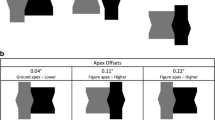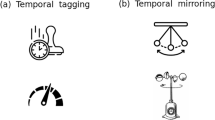Abstract
To study the cortical mechanism of figure/ground categorization in the human brain, we employed fMRI and the temporal-asynchrony paradigm. This paradigm is able to eliminate any differential activation for local stimulus features, and thus to identify only global perceptual interactions. Strong segmentation of the image into different spatial configurations was generated solely from temporal asynchronies between zones of homogeneous dynamic noise. The figure/ground configuration was a single geometric figure enclosed in a larger surround region. In a control condition, the figure/ground organization was eliminated by segmenting the noise field into many identical temporal-asynchrony stripes. The manipulation of the type of perceptual organization triggered dramatic reorganization in the cortical activation pattern. The figure/ground configuration generated suppression of the ground representation (limited to early retinotopic visual cortex, V1 and V2) and strong activation in the motion complex hMT+/V5+; conversely, both responses were abolished when the figure/ground organization was eliminated. These results suggest that figure/ground processing is mediated by top-down suppression of the ground representation in the earliest visual areas V1/V2 through a signal arising in the motion complex. We propose a model of a recurrent cortical architecture incorporating suppressive feedback that operates in a topographic manner, forming a figure/ground categorization network distinct from that for “pure” scene segmentation and thus underlying the perceptual organization of dynamic scenes into cognitively relevant components.



Similar content being viewed by others
References
Allman J, Miezin F, McGuinness E (1985) Direction- and velocity-specific responses from beyond the classical receptive field in the middle temporal visual area (MT). Perception 14:105–126
Anderson JS, Lampl I, Gillespie DC, Ferster D (2001) Membrane potential and conductance changes underlying length tuning of cells in cat primary visual cortex. J Neurosci 21:2104–2112
Angelucci A, Levitt JB, Walton EJ, Hupe JM, Bullier J, Lund JS (2002) Circuits for local and global signal integration in primary visual cortex. J Neurosci 22:8633–8646
Baek K, Sajda P (2005) Inferring figure–ground using a recurrent integrate-and-fire neural circuit. IEEE Trans Neural Syst Rehabil Eng 13:125–130
Bair W, Cavanaugh JR, Smith MA, Movshon JA (2002) The timing of response onset and offset in macaque visual neurons. J Neurosci 22:3189–3205
Blake R, Lee SH (2005) The role of temporal structure in human vision. Behav Cogn Neurosci Rev 4:21–42
Born RT, Bradley DC (2005) Structure and function of visual area MT. Annu Rev Neurosci 28:157–189
Born RT, Tootell RBH (1991) Single-unit and 2-deoxyglucose studies of side inhibition in macaque striate cortex. Proc Natl Acad Sci USA 88:7071–7075
Born RT (2000) Center–surround interactions in the middle temporal visual area of the owl monkey. J Neurophysiol 84:2658–2669
Craft E, Schutze H, Niebur E, von der Heydt R (2007) A neural model of figure–ground organization. J Neurophysiol 97:4310–4326
DeAngelis GC, Freeman RD, Ohzawa I (1994) Length and width tuning of neurons in the cat’s primary visual cortex. J Neurophysiol 71:347–374
Dodd JV, Krug K, Cumming BG, Parker AJ (2001) Perceptually bistable three-dimensional figures evoke high choice probabilities in cortical area MT. J Neurosci 21(13):4809–4821
Eifuku S, Wurtz RH (1999) Response to motion in extrastriate area MSTl: disparity sensitivity. J Neurophysiol 82:2462–2475
Engel SA, Glover GH, Wandell BA (1997) Retinotopic organization in human visual cortex and the spatial precision of functional MRI. Cerebral Cortex 7:181–192
Fahle M (1993) Figure–ground discrimination from temporal information. Proc Roy Soc B Biol Sci 254:199–203
Fitzpatrick D (2000) Seeing beyond the receptive field in primary visual cortex. Curr Opin Neurobiol 10:438–443
Gerrits H, Vendrik A (1970) Simultaneous contrast, filling-in process and information processing in man’s visual system. Exp Brain Res 11:411–430
Gilbert CD, Wiesel TN (1983) Clustered intrinsic connections in cat visual cortex. J Neurosci 3:1116–1133
Gilbert CD, Wiesel TN (1989) Columnar specificity of intrinsic horizontal and corticocortical connections in cat visual cortex. J Neurosci 9:2432–2442
Girard P, Hupé JM, Bullier J (2001) Feedforward and feedback connections between areas V1 and V2 of the monkey have similar rapid conduction velocities. J Neurophysiol 85:1328–1331
Grinvald A, Lieke EE, Frostig RD, Hildesheim R (1994) Cortical point-spread function and long-range lateral interactions revealed by real-time optical imaging of macaque monkey primary visual cortex. J Neurosci 14:2545–2568
Grossberg S, Mingolla E (1985) Neural dynamics of form perception: boundary completion, illusory figures, and neon color spreading. Psychol Rev 92:173–211
Grossberg S (1994) 3-D vision and figure–ground separation by visual cortex. Percept Psychophys 55:48–120
Hupé J-M, James AC, Girard P, Lomber SG, Payne BR, Bullier J (2001) Feedback connections act on the early part of the responses in monkey visual cortex. J Neurophysiol 85:134–145
Hupé JM, James AC, Payne BR, Lomber SG, Girard P, Bullier J (1998) Cortical feedback improves discrimination between figure and background by V1, V2 and V3 neurons. Nature 394:784–787
Kandil FI, Fahle M (2001) Purely temporal figure–ground segregation. Eur J Neurosci 13:2004–2008
Kandil FI, Fahle M (2003) Mechanisms of time-based figure–ground segregation. Eur J Neurosci 18:2874–2882
Knierim JJ, Van Essen DC (1992) Neuronal responses to static texture patterns in area V1 of the alert macaque monkey. J Neurophysiol 67:961–980
Krubitzer LA, Kaas JH (1990) Cortical connections of MT in four species of primates: areal, modular, and retinotopic patterns. Vis Neurosci 5:165–204
Lamme VA (1995) The neurophysiology of figure–ground segregation in primary visual cortex. J Neurosci 15:1605–1615
Lamme VA, Roelfsema PR (2000) The distinct modes of vision offered by feed-forward and recurrent processing. Trends Neurosci 23:571–579
Lamme VA, Zipser K, Spekreijse H (1998) Figure–ground activity in primary visual cortex is suppressed by anesthesia. Proc Natl Acad Sci USA 95:3263–3268
Lamme VA, Zipser K, Spekreijse H (2002) Masking interrupts figure–ground signals in V1. J Cogn Neurosci 14:1044–1053
Lee SH, Blake R (1999) Visual form created solely from temporal structure. Science 284:1165–1168
Lee TS, Mumford D, Romero R, Lamme VA (1998) The role of the primary visual cortex in higher level vision. Vis Res 38:2429–2454
Lu ZL, Sperling G (2001) Three-systems theory of human visual motion perception: review and update. J Opt Soc Am A 18:2331–2370
Maunsell JH, van Essen DC (1983) The connections of the middle temporal visual area (MT) and their relationship to a cortical hierarchy in the macaque monkey. J Neurosci 3:2563–2586
Mumford D (1992) On the computational architecture of the neocortex. II. The role of cortico-cortical loops. Biol Cybern 66:241–251
Nothdurft H-C, Gallant JL, Van Essen DC (1999) Response modulation by texture surround in primate area V1: correlates of “popout” under anesthesia. Vis Neurosci 16:15–34
Nothdurft H-C, Gallant JL, Van Essen DC (2000) Response profiles to texture border patterns in area V1. Vis Neurosci 17:421–436
Olavarria JF, DeYoe EA, Knierim JJ, Fox JM, van Essen DC (1992) Neural responses to visual texture patterns in middle temporal area of the macaque monkey. J Neurophysiol 68:164–181
Palmer SE (1999) Vision science: from photons to phenomenology. Bradford Books/MIT Press, Cambridge, MA
Pao HK, Geiger D, Rubin N (1999) Measuring convexity for figure/ground separation. In: Proceedings of 7th international conference on computer vision, Kerkyra, Greece
Peterson MA, Salvagio E (under review) Context enhances effectiveness of convexity as a figural cue: evidence for biased competition in figure-ground perception
Press WA, Brewer AA, Dougherty RF, Wade AR, Wandell BA (2001) Visual areas and spatial summation in human visual cortex. Vis Res 41:1321–1332
Rockland KS, Knutson T (2000) Feedback connections from area MT of the squirrel monkey to areas V1 and V2. J Comp Neurol 425:345–368
Rockland KS, Van Hoesen GW (1994) Direct temporal-occipital feedback connections to striate cortex (V1) in the macaque monkey. Cereb Cortex 4:300–313
Roelfsema PR, Lamme VA, Spekreijse H, Bosch H (2002) Figure–ground segregation in a recurrent network architecture. J Cogn Neurosci 14:525–537
Rubin E (1921/2001) Visuell wahrgenommene Figuren. Copenhagen: Gyldendalske; reproduced In: Yantis S (ed) Visual perception: essential readings, vol 12. Psychology Press, Philadelphia, pp 225–229
Salvagio E, Mojica AJ, Peterson MA (2008) Context effects in figure-ground perception: the role of biased competition, suppression and long-range connections [Abstract]. J Vis 8(6):1007, 1007a. http://journalofvision.org/8/6/1007
Schira MM, Wade AR, Tyler CW (2007) Two-dimensional mapping of the central and parafoveal visual field to human visual cortex. J Neurophysiol 97:4284–4295
Shmuel A, Yacoub E, Pfeuffer J, Van de Moortele PF, Adriany G, Hu X, Ugurbil K (2002) Sustained negative BOLD, blood flow and oxygen consumption response and its coupling to the positive response in the human brain. Neuron 36:1195–1210
Shmuel A, Augath M, Oeltermann A, Logothetis NK (2006) Negative functional MRI response correlates with decreases in neuronal activity in monkey visual area V1. Nat Neurosci 9:569–577
Sereno MI, Dale AM, Reppas JB, Kwong KK, Belliveau JW, Brady TJ, Rosen BR, Tootell RB (1995) Borders of multiple visual areas in humans revealed by functional magnetic resonance imaging. Science 268:889–893
Super H, Spekreijse H, Lamme VA (2001) Two distinct modes of sensory processing observed in monkey primary visual cortex (V1). Nat Neurosci 4:304–310
Tigges J, Tigges M, Anschel S, Cross NA, Letbetter WD, McBride RL (1981) Areal and laminar distribution of neurons interconnecting the central visual cortical areas 17, 18, 19, and MT in squirrel monkey (Saimiri). J Comp Neurol 202:539–560
Tsotsos JK, Culhane SM, Kei Wai WY, Lai Y, Davis N, Nuflo F (1995) Modeling visual attention via selective tuning. Artif Intell 78:507–545
Tsotsos JK (1997) Limited capacity of any realizable perceptual system is a sufficient reason for attentive behavior. Conscious Cogn 6:429–436
Tyler CW, Likova LT, Kontsevich LL, Chen CC, Schira MM, Wade AR (2005) Extended concepts of occipital retinotopy. Curr Med Imaging Rev 1:319–329
Tyler CW, Likova LT, Kontsevich LL, Wade AR (2006) The specificity of cortical area KO to depth structure. NeuroImage 30:228–238
Ungerleider LG, Desimone R (1986) Cortical connections of visual area MT in the macaque. J Comp Neurol 248:190–222
Verghese P, McKee SP (2002) Predicting future motion. J Vis 2:413–423
von der Heydt R, Zhou H, Friedman HS (2003) Neural coding of border ownership: Implications for the theory of figure–ground perception. In: Behrmann M, Kimchi R, Olson CR (eds) Perceptual organization in vision: behavioral and neural perspectives. Lawrence Erlbaum Associates, Mahwah, pp 281–304
von der Heydt R, Macuda TJ, Qiu FT (2005) Border-ownership dependent tilt aftereffect. J Opt Soc Am (A) 22:2222–2229
Wertheimer M (1923/1938/1997) Laws of organization in perceptual forms. First published as Untersuchungen zur Lehre von der Gestalt II. Psycol Forschung 4:301–350. Trans in Ellis W (1938) A source book of Gestalt psychology, Routledge & Kegan Paul, London, pp 71–88. Reprint (1997) The Gestalt Journal Press, New York
Wertheimer M (1925) Gestalt theory. In: Ellis W (ed) Trans (1938 reprinted 1997). A source book of Gestalt psychology Routledge & Kegan Paul, London, pp 1–11. Reprint (1997) The Gestalt Journal Press, New York
Zhaoping L (2005) Border ownership from intracortical interactions in visual area V2. Neuron 47:143–153
Zhou H, Friedman HS, von der Heydt R (2000) Coding of border ownership in monkey visual cortex. J Neurosci 20:6594–6611
Zipser K, Lamme VA, Schiller PH (1996) Contextual modulation in primary visual cortex. J Neurosci 16:7376–7389
Acknowledgments
This research was supported by National Institutes of Health/National Eye Institute Grant EY 13025. Portions of these results were presented at the Vision Science Society and at the SPIE-Human Vision and Electronic Imaging meetings.
Author information
Authors and Affiliations
Corresponding author
Electronic supplementary material
Below is the link to the electronic supplementary material.
Rights and permissions
About this article
Cite this article
Likova, L.T., Tyler, C.W. Occipital network for figure/ground organization. Exp Brain Res 189, 257–267 (2008). https://doi.org/10.1007/s00221-008-1417-6
Received:
Accepted:
Published:
Issue Date:
DOI: https://doi.org/10.1007/s00221-008-1417-6




